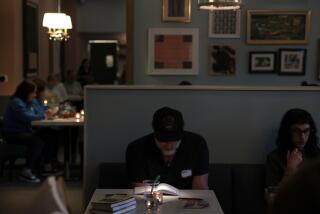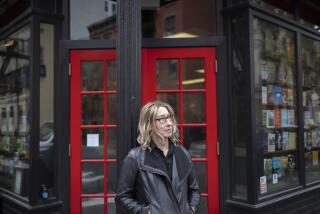The Patron Saint of Bibliophiles : Tony Cima didn’t just collect books. He depended on them, even if they almost killed him.
- Share via
When a 5.2 earthquake struck San Diego on July 13, 1986, Anthony Cima was trapped for 11 hours under his collection of books. The story made the news.
The 87-year-old man lived in a downtown residential hotel in a 12-by-12-foot room stacked to the ceiling with 10,000 books. That only left a small space in the center where he could lie down to sleep or where he could sit up and have a cup of coffee while he read.
The quake struck early Sunday morning. By evening, when Cima’s neighbors hadn’t seen him, they knocked and tried to open the door, but books had wedged it closed. It took firefighters 20 minutes to open the door and another 20 minutes just to find Cima’s foot. To rescue him, firefighters threw many of his books out a second-floor window. Below, Zuhair Zaya and his employees at Barney’s Liquor Store, remembering the old gentleman, respectfully placed the volumes in shopping carts and temporarily stored them in their back room. Cima was rushed to UC San Diego Medical Center that night in critical condition.
I heard about Tony Cima the next day, on an evening television program, when his condition was improving. It was said he woke up and asked for a glass of orange juice and a book. That struck a sympathetic nerve with me. Here was another book-lover, now in a hospital room, no longer surrounded by his usual companions. The next morning I went out to buy him a book.
Wahrenbrock’s Book House is the downtown bookstore near Cima’s hotel, so that’s where I went. Owner Chuck Valverde knew Cima. He told me that the 87-year-old widower actually had some 20,000 books (10,000 in his hotel room and another 10,000 in rented storage space) and that he purchased these with his veteran’s pension and Social Security checks.
“He buys all kinds of books,” Valverde told me, “fiction, nonfiction, histories, condensed books. He rarely pays over a dollar for any one book. And he’s sharp. I don’t think he’s ever bought a duplicate. He has a plan.”
His plan, Valverde said, was to donate his collection to the town of Cima, a place 150 miles northeast of San Bernardino that coincidentally shared his name. He had heard that the bookmobile from Needles only visited this Mojave Desert community once a week. He felt that was a shame. Cima wanted to build a library there.
Remembering Cima’s request when he regained consciousness, I bought him a paperback (Gerald Donaldson’s “Books: Their History, Art, Power, Glory, Infamy and Suffering”) and took it to the hospital and left it for him. Because I wasn’t a blood relative, I wasn’t permitted to see him. I did, however, get to visit with him one afternoon several weeks later, when he was still recuperating at the Veterans Administration Hospital.
He was a small, frail man with thinning white hair, a freckled face and wonderful blue eyes. Alert and gracious, he welcomed me and started talking about his hopes of getting better so he could visit the Public Library again. And he told me about his life.
The son of an Italian immigrant, Cima was a steelworker in Pennsylvania when he bought his first set of books--the 51 volumes of the Harvard Classics. He read them twice. Later, he managed a chain of movie theaters in Pennsylvania. Later still, he founded a small publishing firm, the Cima Publishing Co., which brought out such titles as “The Writings of the Fathers of the Church.” In 1960, he retired and moved to Southern California.
He told me he had four children who were still living, as well as 17 grandchildren and 18 great-grandchildren. “They live all over the country,” Cima said as he fumbled with the folds of a paper puzzle he had created to amuse himself. “We don’t see each other much. They have their own lives. Thanks for the book,” he said, changing the subject.
Tony Cima stayed in the Veterans Hospital a few weeks longer and then, in early September, against his doctor’s advice, he left and returned to his hotel room. He had to do something about the 4,000 books still in his room. The San Diego Housing Division had ordered him to immediately remove them because the weight of the books was a safety hazard; later, senior housing inspector Bill Lyon granted Cima a month’s extension.
In the meantime, however, librarians in Needles indicated that (despite Tony’s hopes) there was no real need to build a library in the community of Cima since the size of the town (permanent population between 4 and 12) really did not warrant it.
Learning of Cima’s troubles with the Housing Division, the manager of San Diego’s Interstate Self Storage, Red Kaster, stepped forward and offered to store Cima’s books for free. Kaster even recruited 25 volunteers to move the books to the storage facility. Another firm, Fidelco Communications Corp. in San Ysidro, donated 100 boxes to cart the books.
“I told Tony I would take him in my car to come out and sit with the books anytime he wanted,” Kastner told journalists, “we will even furnish a chair.”
But Tony got cold feet in late September and, at the last moment, called the move off. “Tony said he has a chance to sell the whole collection,” Kastner reported at the time, “but I think he loves those books so much he hates to see them go.” Really, he had no choice, so in October, the books were moved to the donated space.
A few weeks later, on Nov. 19, 1986, Tony Cima was found dead in his hotel room. The firefighters, summoned again by neighbors, were the first to enter the room and find his decomposed body. According to the coroner, he had been dead for several days. Some of those same people--among them Fire Capt. Larry Williamson and firefighters Ralph Haynes and John Handley--were among the volunteers a few weeks later when Cima’s 10 tons of books were moved from the storage space to a city library facility. Tony’s books were given to the Friends of the Public Library. Everyone agreed he would have been happy about that.
More to Read
Sign up for Essential California
The most important California stories and recommendations in your inbox every morning.
You may occasionally receive promotional content from the Los Angeles Times.









